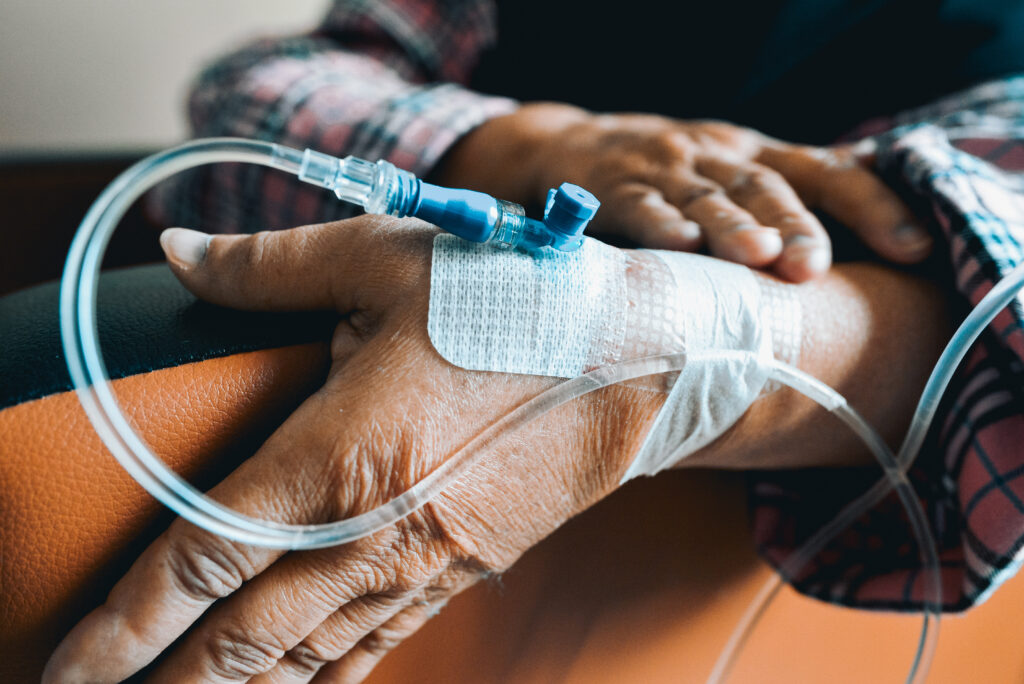Cancer treatment often involves tough decisions, and two of the most widely used methods are chemotherapy and radiation therapy. Though both aim to destroy cancer cells, they do so in completely different ways. Many patients and caregivers wonder: What exactly is the difference between chemo and radiation? Which treatment works better? Can they be used together?
Understanding what chemotherapy and radiation are, and how each works, can make the treatment journey clearer, more manageable, and less overwhelming.
In many cancer cases, doctors may recommend using both treatments — either one after the other or simultaneously — a combination known as chemoradiation therapy. This approach can enhance effectiveness but also increases the cost and duration of treatment.
In this blog, we’ll break down the key differences between chemotherapy and radiotherapy, explain how they work, when each is used, and how they can be combined to improve treatment outcomes.
Read More: Top 5 Cancer Patient Help Funds in Mumbai
Read More: बार्थोलिन सिस्ट के लक्षण, कारण और इलाज
Table of Contents
What is Chemo and Radiation as Cancer Treatment?

To understand the difference between chemotherapy and radiation, it’s important first to explore how each treatment works and what makes them unique. Both are among the most widely used cancer therapies, yet they function in very different ways to fight the disease
What is Radiation Therapy?
Radiation therapy, also called radiotherapy, uses high-energy rays — such as X-rays, gamma rays, or particle beams — to target and destroy cancer cells. It works by damaging the DNA of cancer cells, preventing them from growing or dividing. Over time, these damaged cells die, and the body naturally removes them.
Radiation therapy is typically a local treatment, meaning it focuses on a specific part of the body. It’s often recommended for cancers confined to one region, such as brain tumors, breast cancer, or prostate cancer.
There are two main ways radiation is delivered:
- External Beam Radiation Therapy (EBRT): A machine directs radiation from outside the body toward the tumor.
- Internal Radiation Therapy (Brachytherapy): Radioactive implants or seeds are placed inside or near the tumor by a tumor specialist.
In some cases, doctors combine radiation therapy with chemotherapy, known as chemoradiation therapy, for a stronger, more targeted effect — especially in aggressive or advanced cancers.
What is Chemotherapy?
Chemotherapy is a systemic treatment that uses powerful anti-cancer drugs to kill or slow the growth of cancer cells throughout the body. Unlike radiation, which targets a localized area, chemotherapy circulates through the bloodstream, making it effective for cancers that have spread or are at risk of spreading.
Chemotherapy works by disrupting the cell division process. Since cancer cells divide rapidly, the drugs target these fast-growing cells. However, some healthy cells — such as those in the hair follicles, digestive tract, and bone marrow — also divide quickly, which is why side effects like hair loss or nausea can occur.
Chemotherapy can be:
- Used alone or in combination with surgery and radiation therapy.
- Part of chemoradiation therapy, particularly for cervical, lung, and head & neck cancers.
Patient Insight
In India, where access to advanced treatments can be limited by cost, many patients use medical crowdfunding platforms like ImpactGuru to raise funds for chemotherapy, radiotherapy, or combined cancer care, ensuring timely and uninterrupted treatment.

Chemotherapy vs Radiation Therapy: The Core Differences
Now that we’ve explored both treatments individually, let’s clearly understand the difference between chemotherapy and radiation therapy.
While both aim to destroy cancer cells, they differ in how they’re delivered, which areas they affect, and the types of side effects they cause. These differences are crucial in deciding the right treatment plan for each patient.
| Aspect | Chemotherapy | Radiation Therapy (Radiotherapy) |
| Treatment Type | Systematic type that affects the entire body | Local type that targets a specific part of the body |
| Method | Drugs are administered orally or via IV | High-energy rays or particles directed at the cancer site |
| Purpose | It destroys cancer cells throughout the body | It destroys cancer cells in a localized area |
| Common Side Effects | Hair loss, nausea, fatigue, and low immunity | Skin irritation, localized fatigue, swelling |
| Frequency | Given in cycles over weeks or months | Often, daily over a set number of weeks |
| Used For | Cancers that may have spread or are systemic | Localized cancers or tumors |
| Combination Use | Often combined with radiation or surgery | Often used with chemotherapy (chemoradiation therapy) |
The main difference between chemo and radiation lies in their scope and delivery:
- Chemotherapy travels through the entire bloodstream, reaching cancer cells across the body.
- Radiation therapy focuses precisely on one region, targeting the tumor directly.
Depending on the type and stage of cancer, doctors may recommend one treatment or a combination of both to improve outcomes.
Radiotherapy vs Chemotherapy: When is Each Used?
Choosing between chemotherapy and radiation therapy depends on several factors — including the type of cancer, its location, stage, and whether it has spread. While both are effective, they aren’t interchangeable. Each plays a unique role in a patient’s cancer treatment plan, and in some cases, they’re used together for better results.
Let’s look at when chemotherapy and radiation are used in different treatment situations.
When Is Chemotherapy Used?
Chemotherapy is a systemic treatment, meaning it travels through the bloodstream to reach cancer cells throughout the body. It’s typically used when the disease is widespread or has a high risk of spreading.
Common scenarios where chemotherapy is recommended:
- Widespread or metastatic cancer:
Ideal for cancers that have spread beyond one area — such as leukemia, lymphoma, or advanced breast cancer. - Before surgery or radiation (Neoadjuvant chemotherapy):
Helps shrink tumors to make surgery or radiation more effective. - After surgery or radiation (Adjuvant chemotherapy):
Used to kill any remaining cancer cells and prevent recurrence. - Blood cancers and fast-growing tumors:
Often, the first line of treatment for cancers affecting the blood or immune system, where localized therapies are less effective.
When Is Radiation Therapy Used?
Radiation therapy, or radiotherapy, is a local treatment that targets a specific area of the body using high-energy rays to destroy cancer cells. It’s often used when the tumor is confined to one region.
Common scenarios where radiation therapy is recommended:
- Localized tumors:
Effective for cancers contained in a single area — such as brain tumors, cervical cancer, or early-stage prostate cancer. - Before surgery (Neoadjuvant radiotherapy):
Helps shrink the tumor to make surgery easier or more successful. - After surgery (Adjuvant radiotherapy):
Destroys any remaining cancer cells in the treated area to reduce recurrence risk. - Palliative treatment:
Used in advanced-stage cancers to relieve pain, reduce bleeding, or improve quality of life by shrinking tumors pressing on nearby organs.
When doctors want to increase the chances of killing cancer cells, they may recommend chemoradiation therapy, a combination of both treatments. This combined approach is a practical example of what chemotherapy and radiation therapy are, often used in cancers of the cervix, head and neck, esophagus, and lungs, where a stronger response is needed without immediate surgery.
What Is Chemoradiation Therapy?
In some cancer cases, doctors recommend a combined approach known as chemoradiation therapy, where chemotherapy and radiation therapy are administered together. This combination enhances the overall effectiveness of treatment, especially for cancers that are aggressive or located in sensitive areas.
During chemoradiation, chemotherapy acts as a radiosensitizer, making cancer cells more vulnerable to radiation’s effects. This synergy increases the chances of destroying the tumor while reducing the likelihood of recurrence.
When Is Chemoradiation Therapy Used?
Chemoradiation is commonly prescribed for:
- Cervical cancer
- Head and neck cancers
- Esophageal cancer
- Rectal cancer
- Lung cancer (especially non-small cell types)
It may be recommended when:
- Surgery isn’t an immediate option
- The goal is to shrink the tumor before surgery
- Organ preservation is important (e.g., voice box, anus)
Benefits of Chemoradiation Therapy
- Stronger combined effect on tumor cells
- Improved survival rates in specific cancer types
- Lower recurrence rates when appropriately used
- Organ preservation reduces the need for major surgery
Since chemoradiation combines two intensive therapies, side effects can be more pronounced, including fatigue, nausea, and localized discomfort, depending on the treatment area. Still, it remains one of the most effective and widely practiced strategies in modern oncology, offering the systemic reach of chemotherapy with the precise targeting of radiation therapy.
Conclusion
Understanding what chemotherapy and radiation are is essential for anyone navigating a cancer diagnosis, whether for themselves or a loved one. While both treatments aim to fight cancer, they work in distinct ways: chemotherapy treats the entire body with cancer-killing drugs, while radiation therapy targets specific areas with high-energy rays. Each has its benefits, side effects, and purpose in a treatment plan.
In many cases, doctors may recommend both treatments together, known as chemoradiation therapy, to increase effectiveness and improve outcomes. With advancements in cancer care, these therapies continue to save lives and offer hope to millions.
However, access to these treatments can be expensive, especially when extended over several sessions or combined with surgery and hospitalization. That’s where crowdfunding websites like ImpactGuru can make a real difference. By raising funds online, families can ease the financial burden and focus on what truly matters: healing and recovery.
FAQs
Chemotherapy uses drugs to kill or slow the growth of cancer cells throughout the body.
Radiation therapy uses high-energy radiation (X-rays, gamma rays) to destroy cancer cells in a targeted area.
Chemo is systemic (affects the entire body) while radiation is localized; chemo has drug side-effects, and radiation effects are more localized to the treated area.
Yes — they are often combined (called chemoradiation) to increase effectiveness, especially when tumors are hard to remove or in certain cancer types.
Common chemo side-effects include nausea, hair loss, and immune suppression; radiation side-effects often include skin irritation at the treatment site, fatigue, and localized swelling.












